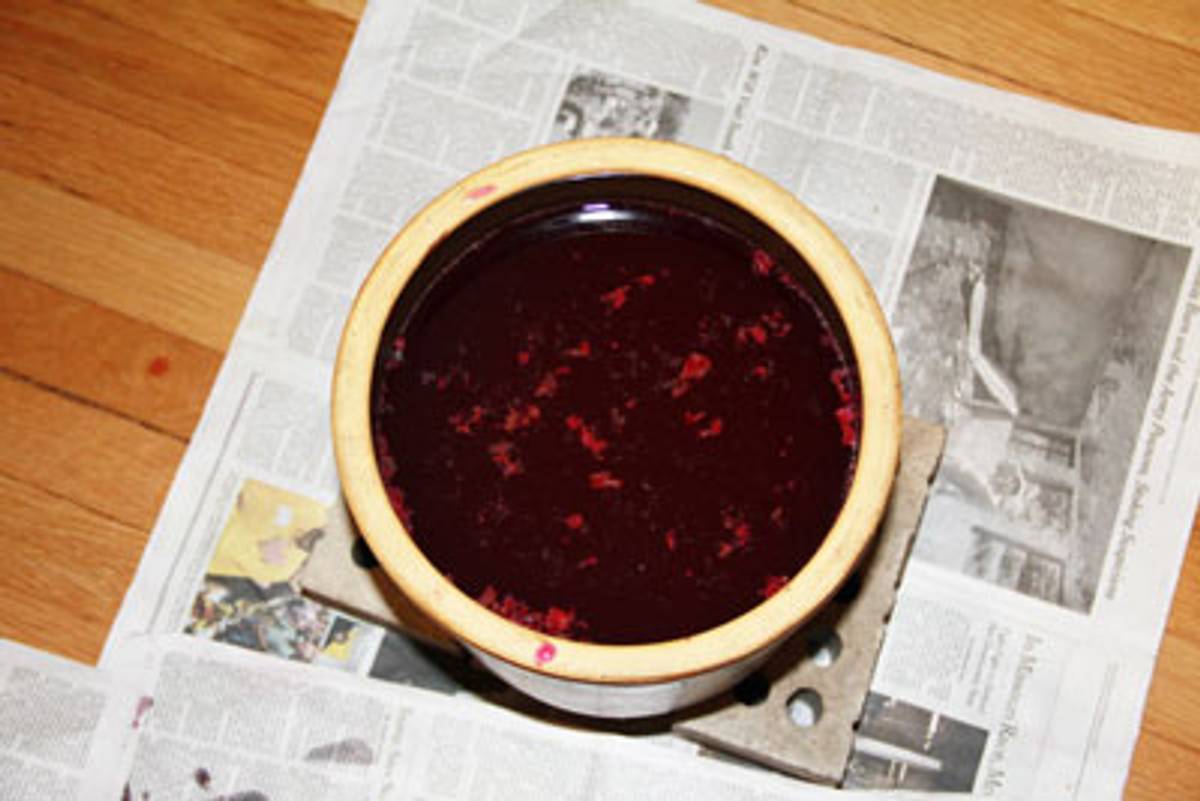The Key to Old World Borscht
On the Upper West Side, Nach Waxman keeps an Eastern European culinary tradition alive in his ceramic crock: a fermented beet brine called russel




In a far corner of Nach Waxman’s handsome, prewar apartment living room sits a two-gallon ceramic crock perched over three stout bricks. To the casual observer, the tableau might go entirely unnoticed or get written off as a bit of eccentric décor. But inside the unassuming vessel, glazed in muted browns and grays, a whole world is unfolding.
As founding partner of Kitchen Arts & Letters, a bookstore he opened in 1983 focusing exclusively on food- and drink-related tomes, Waxman, 82, has become something of a legend within culinary and publishing circles. (His limitless curiosity about food history and encyclopedic knowledge of rare cookbooks haven’t hurt either.) He is a longtime fixture of New York City’s Upper West Side—he and his wife moved into their apartment in 1968 when rent was $226, raised their kids, and bought when the building went coop in 1985. Waxman is also a devoted maker and consumer of russel, the tangy, fermented beet brine traditionally used by Eastern European Jews to flavor borscht.
Before meeting Waxman, I had read about russel in cookbooks—like Mildred Grosberg Bellin’s 1941 The Jewish Cook Book, which includes a recipe for hot Passover borscht made from “1 cup of strained rosel liquid for each portion,” diluted with water or broth and thickened with beaten egg yolks.
All of the borscht recipes I knew were soured with lemon juice or vinegar, or occasionally sour salt (citric acid) if they were old school. So I had filed russel away as an intriguing tidbit of Jewish culinary tradition lost to history. Then last fall I stumbled across Waxman’s spirited entry on russel in a 2015 community cookbook published by his Upper West Side synagogue, Ansche Chesed. I immediately reached out.
His emailed reply was swift and generous: “What a happy coincidence! It just happens that a bit over three weeks ago I started a crock of russel. If you can get over here in the next two weeks … [you could] get a look at the crock, see what the russel is like at a middling stage, have a sip if you wish, and take a picture or two.”
The timing was indeed coincidental. For generations, russel (the word, which is also written as rosl, stems from the Slavic term for brine) was traditionally prepared in the weeks leading up to Passover. The last of the previous autumn’s beets, which would have been chilling and growing scraggly in the root cellar all winter, were unearthed along with a ceramic crock reserved for the purpose. The beets were peeled, chopped, covered with water, and set to ferment until the first Seder. By then, the liquid would have transformed into a potent beet broth with a sharp bite that would flavor the holiday’s borscht pots.
Waxman had always followed suit, putting up his batches of russel sometime in March. But the previous Passover, an illness had prevented him from completing his annual ritual. So when he spotted a beautiful pile of late summer beets at a local farmer’s market, he felt compelled to attempt an “off-season” batch. Reaching out to him, I had assumed we would set up a phone interview. Instead, I hopped on the subway near my home in Brooklyn and emerged an hour later on the Upper West Side, en route to sample a flavor of the past.
*
Waxman was raised in Vineland, a southern New Jersey town about 30 miles outside of Philadelphia. The area’s Jewish community was founded in the late 19th century and bankrolled in part by Baron Maurice de Hirsch, a German-Jewish philanthropist who helped Jewish immigrants flee religious persecution in Europe and start agricultural homesteads in America.
Vineland first attracted Germans and Austrians, mostly highly educated people who viewed themselves as above the poultry-farming life. “They couldn’t wait to stop hauling around chicken droppings,” Waxman said. As they began abandoning their farms at the end of the war, the land was snapped up by newcomers, largely Holocaust survivors from Poland and Russia. Waxman’s family is, by his own estimation, “solid and serious Romanian on one side and kind of Russian on the other.”
Waxman’s father worked in real estate and insurance (mostly buying and selling chicken farms), and his mother was a dedicated volunteer for Jewish causes. She was also master of the household and steward of the family’s russel crock. “My family did not stay farmers, but we were surrounded by them,” Waxman said. As such, aspects of their lives continued to be guided by both Jewish tradition and the seasonal rituals of farm life. And so each year, Waxman watched his mother make russel.
“Growing up, we kept the crock in a special cabinet in our cellar where the Passover dishes were stored,” he said. “It was something you waited for. There was real excitement when the crock came out and the beets were done.” There were a handful of smaller crocks and jars in the Waxmans’ cellar, too—other preserved fruits and vegetables that families used to extend the summer harvest. But russel, which Waxman wrote in the Ansche Chesed cookbook, “heralded, as clearly as a shofar blast, that change was on the way—that we were beginning the countdown to Pesach,” was the crown jewel.
Today, Waxman is the caretaker of the vessel that his mother (and likely his mother’s mother) used to make russel. He takes its pedigree seriously. “We are not strictly kosher,” he said of his own household. “But we keep the sanctity of the crock.” His russel process begins exactly like his mother’s, with nothing more than quartered beets and water. Unlike other traditionally fermented products (sauerkraut, cucumber pickles, etc.), no salt is added. Instead, the alchemical process is powered by the natural sugars in the beets converting to alcohol. The crock is placed in the living room, which, in lieu of a root cellar, Waxman deemed the coolest spot in his apartment.

“My mother was mostly interested in the liquid brine,” he said—the acidic nectar that, after a winter of heavy stews and roasts, surely tasted like spring manifested. Waxman likes to use the fermented beets as well, pairing them with onion in salads or cooking them into brisket. “They break down almost completely into the sauce, flavoring the juices.” For borscht, he combines the russel beets and liquid with more freshly boiled beets (to cut the sharpness), onion, sour cream (or, in more recent years, labneh), and salt. The mixture is blended until completely smooth, chilled, and drunk from a glass like a soupy tonic. “Drinking it cold is one of the charms,” he said. “It is meant to be bracing.”
When he opened the crock on the day I visited, lifting off the heavy lid and peeling back several gauzy layers of cheesecloth, we were greeted—as expected—with a half-inch-thick layer of muck that is a natural part of the fermentation process. “The first two weeks are pretty lurid,” Waxman conceded. “But you can’t make it without the mold.” Like his mother before him, he skimmed off the offending layer slowly, revealing a bruise-colored liquid underneath, which he assessed as on its way, but too cloudy as of yet. When the process is complete, russel brine turns crystalline and ruby hued. “Clear enough to read The New York Times through,” Waxman said, using a distinction typically reserved for sliced lox and hand-stretched strudel dough. It should also taste quite sharp, like vinegar. “You wouldn’t want to sit and eat a whole bowl of it,” Waxman said.
After skimming, he ladled a little of the liquid into cups and we took sips. It was earthy, funky, and slightly sweet, but did not have much in the way of the characteristic sharpness or edge. Waxman seemed a bit flustered by the results. He apologized for serving lackluster russel and began speculating about where a misstep might have occurred.
I wondered aloud if maybe timing was his issue. After all, russel is traditionally made with last season’s beets—roots picked in late fall after the first frost (which converts some of the vegetables’ starch into sugar) and wintered in a root cellar before being called upon for the task. The beets he had started with, by contrast, were from a farmer’s market—likely picked within a few days of fermentation and potentially too fresh to offer much in the way of sugar content. Waxman’s eyes lit up at the thought. “I think you might be on to something,” he said. To compensate, he decided to spike his liquid with a teaspoon or two of cane sugar, just enough to kick the fermentation process into high gear.
About three weeks after I visited, I received the following dispatch from Waxman: “I gave the brew two infusions of sugar … which did the job pretty well. It is not the all-time [best] russel I’ve ever made, but it is miles ahead of that wimpy purplish water … a nice rich red [with] some real body to it.”
*
There are plenty of reasons why russel isn’t likely to make a dramatic comeback with contemporary Jewish home cooks. Despite a resurgence in interest with traditional fermentation overall, the sheer amount of glop involved is a lot to stomach. “As soon as most people hear they are going to have to remove this much mold, they back out,” Waxman said. Besides, borscht sharpened with a splash of lemon juice and a glug of apple cider vinegar (citrus juice alone is too mild for my taste) is bright and delicious.
But for Waxman, the familial connections and the sense of “anything can happen” adventure that comes with preparing russel makes continuing the tradition worthwhile. This spring, Waxman wrote me, he will be at it again. “I’ll make a new batch for Passover with those sugar-packed storage beets,” he said. “And if you trust me this time, I’ll make up a container for you.” I wouldn’t miss it.
***
Like this article? Sign up for our Daily Digest to get Tablet magazine’s new content in your inbox each morning.